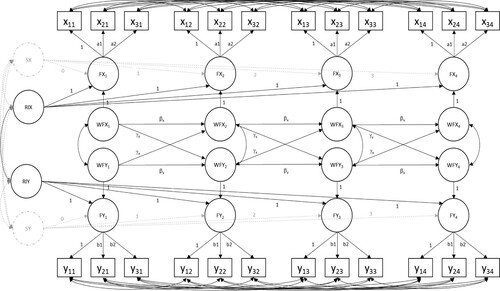Figures & data
Table I. Item content of primary instruments.
Figure 1. Bivariate multiple indicator random intercept cross-lagged panel model (only 4 of 6 timepoints displayed). Xij, Yij = observed indicators (i) for respectively AB (X) and COG (Y) at time j; FXj, FYj = latent factors for respectively AB(X) and COG (Y) at time j; RIX, RIY = random intercept for respectively AB(X) and COG (Y) – between part of the model; WFXj, WFYj = within-part of the model for respectively AB(X) and COG (Y) at time j; SX, SY = random slopes for respectively AB(X) and COG (Y) – LCM-SR model only; βx, βy = autoregressive coefficients; and γx, γy = reciprocal coefficients.

Table II. Unstandardized parameter estimates and model fit indices from different cross-lagged panel models for avoidance behavior (y) and cognitions (x).
Table III. Standardized parameter estimates from the multiple indicator random intercept cross-lagged panel model (RI-CLPM) for avoidance behavior (AB) and cognitions (COG).
